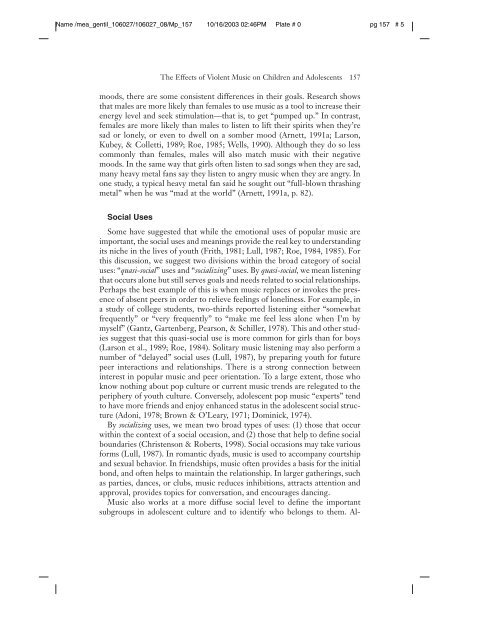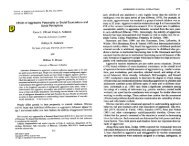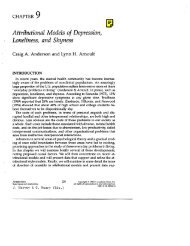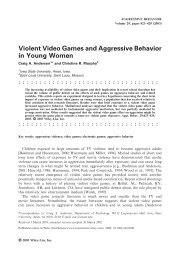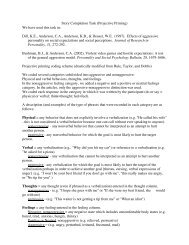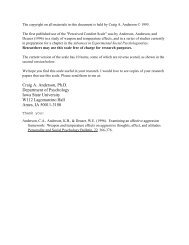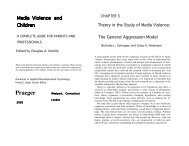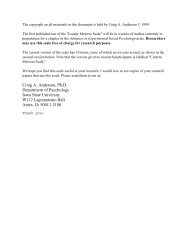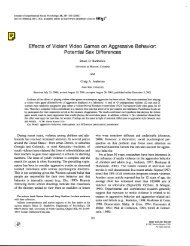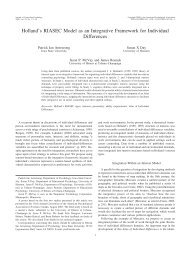The Effects of Violent Music on Children and Adolescents
The Effects of Violent Music on Children and Adolescents
The Effects of Violent Music on Children and Adolescents
You also want an ePaper? Increase the reach of your titles
YUMPU automatically turns print PDFs into web optimized ePapers that Google loves.
Name /mea_gentil_106027/106027_08/Mp_157 10/16/2003 02:46PM Plate # 0 pg 157 # 5<br />
<str<strong>on</strong>g>The</str<strong>on</strong>g> <str<strong>on</strong>g>Effects</str<strong>on</strong>g> <str<strong>on</strong>g>of</str<strong>on</strong>g> <str<strong>on</strong>g>Violent</str<strong>on</strong>g> <str<strong>on</strong>g>Music</str<strong>on</strong>g> <strong>on</strong> <strong>Children</strong> <strong>and</strong> <strong>Adolescents</strong> 157<br />
moods, there are some c<strong>on</strong>sistent differences in their goals. Research shows<br />
that males are more likely than females to use music as a tool to increase their<br />
energy level <strong>and</strong> seek stimulati<strong>on</strong>—that is, to get “pumped up.” In c<strong>on</strong>trast,<br />
females are more likely than males to listen to lift their spirits when they’re<br />
sad or l<strong>on</strong>ely, or even to dwell <strong>on</strong> a somber mood (Arnett, 1991a; Lars<strong>on</strong>,<br />
Kubey, & Colletti, 1989; Roe, 1985; Wells, 1990). Although they do so less<br />
comm<strong>on</strong>ly than females, males will also match music with their negative<br />
moods. In the same way that girls <str<strong>on</strong>g>of</str<strong>on</strong>g>ten listen to sad s<strong>on</strong>gs when they are sad,<br />
many heavy metal fans say they listen to angry music when they are angry. In<br />
<strong>on</strong>e study, a typical heavy metal fan said he sought out “full-blown thrashing<br />
metal” when he was “mad at the world” (Arnett, 1991a, p. 82).<br />
Social Uses<br />
Some have suggested that while the emoti<strong>on</strong>al uses <str<strong>on</strong>g>of</str<strong>on</strong>g> popular music are<br />
important, the social uses <strong>and</strong> meanings provide the real key to underst<strong>and</strong>ing<br />
its niche in the lives <str<strong>on</strong>g>of</str<strong>on</strong>g> youth (Frith, 1981; Lull, 1987; Roe, 1984, 1985). For<br />
this discussi<strong>on</strong>, we suggest two divisi<strong>on</strong>s within the broad category <str<strong>on</strong>g>of</str<strong>on</strong>g> social<br />
uses: “quasi-social” uses <strong>and</strong> “socializing” uses. By quasi-social, we mean listening<br />
that occurs al<strong>on</strong>e but still serves goals <strong>and</strong> needs related to social relati<strong>on</strong>ships.<br />
Perhaps the best example <str<strong>on</strong>g>of</str<strong>on</strong>g> this is when music replaces or invokes the presence<br />
<str<strong>on</strong>g>of</str<strong>on</strong>g> absent peers in order to relieve feelings <str<strong>on</strong>g>of</str<strong>on</strong>g> l<strong>on</strong>eliness. For example, in<br />
a study <str<strong>on</strong>g>of</str<strong>on</strong>g> college students, two-thirds reported listening either “somewhat<br />
frequently” or “very frequently” to “make me feel less al<strong>on</strong>e when I’m by<br />
myself” (Gantz, Gartenberg, Pears<strong>on</strong>, & Schiller, 1978). This <strong>and</strong> other studies<br />
suggest that this quasi-social use is more comm<strong>on</strong> for girls than for boys<br />
(Lars<strong>on</strong> et al., 1989; Roe, 1984). Solitary music listening may also perform a<br />
number <str<strong>on</strong>g>of</str<strong>on</strong>g> “delayed” social uses (Lull, 1987), by preparing youth for future<br />
peer interacti<strong>on</strong>s <strong>and</strong> relati<strong>on</strong>ships. <str<strong>on</strong>g>The</str<strong>on</strong>g>re is a str<strong>on</strong>g c<strong>on</strong>necti<strong>on</strong> between<br />
interest in popular music <strong>and</strong> peer orientati<strong>on</strong>. To a large extent, those who<br />
know nothing about pop culture or current music trends are relegated to the<br />
periphery <str<strong>on</strong>g>of</str<strong>on</strong>g> youth culture. C<strong>on</strong>versely, adolescent pop music “experts” tend<br />
to have more friends <strong>and</strong> enjoy enhanced status in the adolescent social structure<br />
(Ad<strong>on</strong>i, 1978; Brown & O’Leary, 1971; Dominick, 1974).<br />
By socializing uses, we mean two broad types <str<strong>on</strong>g>of</str<strong>on</strong>g> uses: (1) those that occur<br />
within the c<strong>on</strong>text <str<strong>on</strong>g>of</str<strong>on</strong>g> a social occasi<strong>on</strong>, <strong>and</strong> (2) those that help to define social<br />
boundaries (Christens<strong>on</strong> & Roberts, 1998). Social occasi<strong>on</strong>s may take various<br />
forms (Lull, 1987). In romantic dyads, music is used to accompany courtship<br />
<strong>and</strong> sexual behavior. In friendships, music <str<strong>on</strong>g>of</str<strong>on</strong>g>ten provides a basis for the initial<br />
b<strong>on</strong>d, <strong>and</strong> <str<strong>on</strong>g>of</str<strong>on</strong>g>ten helps to maintain the relati<strong>on</strong>ship. In larger gatherings, such<br />
as parties, dances, or clubs, music reduces inhibiti<strong>on</strong>s, attracts attenti<strong>on</strong> <strong>and</strong><br />
approval, provides topics for c<strong>on</strong>versati<strong>on</strong>, <strong>and</strong> encourages dancing.<br />
<str<strong>on</strong>g>Music</str<strong>on</strong>g> also works at a more diffuse social level to define the important<br />
subgroups in adolescent culture <strong>and</strong> to identify who bel<strong>on</strong>gs to them. Al-


